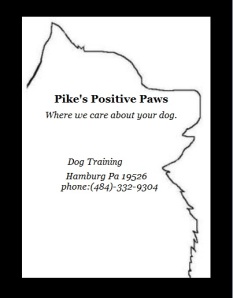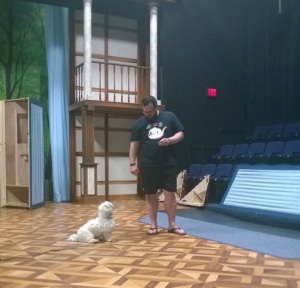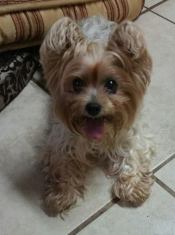
Sometimes the dog training lingo can be a little overwhelming. As in many fields, the professionals seem to have their own language that is not easily or readily understood by the public at large. Dog trainers are no different. To make it worse, we use acronyms to avoid spelling out those long words. I am as guilty as any other dog training professional of writing OC in place of Operant Conditioning or CC&D for Counter Conditioning and Desensitization.
An acronym that has been coming up a lot recently is +CER. To a pet dog owner, that could mean anything from “Add Correct Energy Reaction” to “Increase Carrots, Eggs and Radishes”.
So what exactly IS a +CER?
A CER is a conditioned emotional response. It is a learned, emotional reaction. It is a subset of classical conditioning because the subject makes a reflexive association with the trigger. There is no behavior involved. Think Pavlov’s dogs. Bell rings, dogs salivate. The bell has become the predictor of food. That is classical conditioning. And the dogs probably experienced an emotional reaction to the sound of the bell, which would make it a CER.
I will take it a step further and guess that the response the dogs had to the sound of the bell was a pleasant response as it predicted something they enjoyed, food. That means it is a +CER.
We hear a song on the radio and suddenly we are at the beach in our senior year, hanging out with our friends in the sun. That is a + CER (unless you hate the beach). Or we smell turkey and we re-experience a long ago Christmas with loved ones. One of my strongest +CER’s is to a perfume. I wore it for the first time in Jamaica and every time I smell it, I am back in Jamaica in my mind. I can almost feel the tile under my feet and the warm breeze from the balcony and I suddenly feel very calm. THAT is a +CER. It is a stimulus (to use the technical word) that triggers a positive emotional response due to its association with something pleasant.
Why do I care?

Scott classically conditioning a +CER with Duncan
Over the summer, my dog, Duncan, was in a play. The director wanted Duncan to follow Scott, the actor playing his owner, with total adoration in Duncan’s eyes, no matter what. The problem was that there were times when the script called for Scott to speak to Duncan quite harshly, at times, even threateningly. This could be quite intimidating for a small dog, so we decided to create positive emotional responses to both Scott and the harsh words and threatening gestures. We set about feeding Duncan while gradually increasing the intensity of the tone and gestures. During the time that the intimidating parts of the script were being rehearsed, food flowed freely. When they were over, the food stopped. It did not take long till Scott’s loud words and assertive movements produced the desired response, loving looks from Duncan. In Scott’s words, “It all became a meatball”. Duncan not only did not mind Scott berating him on stage, he enjoyed it.

The Finished Product
The most important reason we should care is the emotional well being of our dogs. Being distressed by things that should not cause a stressful response is…well…stressful. If my dog is terrified of the sound the dishwasher makes, he is going to have a fearful reaction every time it runs. That cannot be a pleasant feeling. The reduction in anxiety or distress is reason enough to consider creating a +CER.
Emotions often drive behavior and a dog may act out behaviorally based on how they feel about a trigger. And even though the emotion driving the response may not make sense to us, it is very real to the dog. He may bark when the dishwasher begins to make a scary noise, he may try to run, hide or avoid the noise from the dish washer, and, in a worst case scenario, he could experience a fight or flight response and become aggressive. He may even learn to associate the loading of the dishwasher with the scary noise. Meal time and clean up could become quite stressful for a dog that experienced this every day.
Although classical conditioning is related to reflexive, internal and/or emotional responses rather than behavioral responses, the way we (or our dogs) feel about something can affect the way we react. If I use counter conditioning to associate the dish washer with something good (like food), I can create the dish washer as a +CER and, in normal, physically healthy dogs, altering the CER changes behavior. The dog no longer has a reason to react to the scary noise the dishwasher makes because, in his mind, it equals something pleasant.
“CARE for Reactive Dogs has excellent advice for creating a +CER here:
http://careforreactivedogs.com/care-protocol-content/#associate
Knowing how to create a +CER is a useful tool for any owners tool bag. It does not matter if we own a puppy, an adult or a senior dog, they all can benefit from making positive associations with things that should not be scary.

 When we reward dogs for compliance, we create positive association with the action and with us. Sit is no longer an action the dog has to take to avoid something unpleasant. It becomes something the dog enjoys doing because it makes good things happen. The cue becomes a happy thing. As we continue to work with our dogs, we become associated with those good things. Our dogs begin to enjoy working with us as a team and the relationship grows.
When we reward dogs for compliance, we create positive association with the action and with us. Sit is no longer an action the dog has to take to avoid something unpleasant. It becomes something the dog enjoys doing because it makes good things happen. The cue becomes a happy thing. As we continue to work with our dogs, we become associated with those good things. Our dogs begin to enjoy working with us as a team and the relationship grows.







